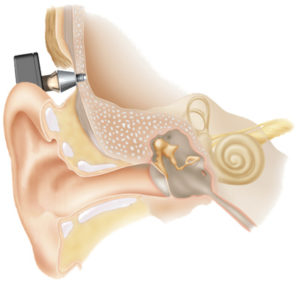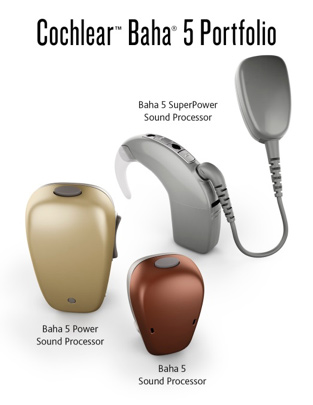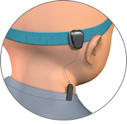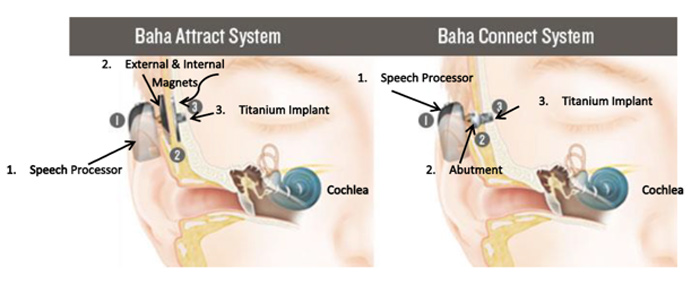Baha® SYSTEM: OSSEOINTEGRATED TEMPORAL BONE SYSTEM
What is a Baha®?

Who can benefit from a Baha®?
Individuals with chronic middle ear conditions or middle or outer ear congenital anomalies who cannot use a conventional hearing aid are potential candidates for Baha®. This may include individuals with chronic middle ear drainage, individuals with external ear canal anomalies or individuals with conductive or mixed hearing loss who do not receive sufficient benefit from conventional air conduction hearing aids.
The Baha® may also be indicated for individuals with severe profound sensori-neural hearing loss in one ear.
How does the Baha® work?
- A small titanium implant is placed in the bone behind the ear. Implantation requires a short outpatient procedure. After healing and allowing time for the implant to osseointegrate (attach firmly to the bone), the external component (sound processor) is attached.
- The external sound processor picks up sound vibrations and sends them to the internal implant in one of two ways:
- The Baha® Connect The external processor snaps into a small abutment that sits on the skin and connects directly to the titanium implant. Sound vibrations from the processor are sent directly through the bone to the inner ear (cochlea), stimulating the inner hair cells (nerve cells) and eliciting a sensation of hearing.
- The Baha® Attract provides a magnetic connection between the implant and the external speech processor. During surgery, the implant is attached to a magnet that is placed under the scalp. Once activated, the speech processor is connected to an external magnet that sits on the scalp and communicates with the internal magnet. Sound is transmitted via these magnets to the implant and the inner ear is stimulated.
Who is a potential candidate for a Baha®?

Individuals with conductive or a mixed hearing loss: Individuals with at least a 30 dB HL conductive component and no worse than a moderate sensori-neural loss may benefit from direct stimulation of the cochlea. Typically these are individuals who cannot wear or receive limited benefit from traditional air conduction hearing aids.
Three different speech processors accommodate various degrees of hearing loss. Candidacy for each device is based upon the degree of sensori-neural hearing loss.
Baha® 5: Bone conduction thresholds up to 45 dB HL
Baha® 5 Power: Bone conduction thresholds up to 55 dB HL
Baha® 5 Super Power: Bone conduction thresholds up to 65 dB HL
What is a “Baby Baha®?

How do I know if I am a Baha®Candidate?
Evaluation for Baha® is performed by a neurotologist and an audiologist.
- Neurotologist (ear surgeon subspecialist):
- The neurotologist performs a thorough case history and physical examination.
- In addition, the doctor orders radiologic studies, such as CT scan and/or MRI scan to evaluate the integrity of the outer, middle and inner ear and auditory nerve.
- If approved for the Baha®, the neurotologist performs the implant surgery and provides regular medical care for the implant long term.
- Audiologist:
- The audiologist performs a basic audiologic assessment to confirm your hearing levels.
- Testing is performed to measure your hearing levels and your ability to understand speech with a traditional hearing aid, if possible and with a Baha® coupled to a headband.
Do I need any other listening equipment?
Many individuals find that they can further improve their ability to understanding spoken language by using other types of technology in conjunction with their Baha®. The Baha® can be ordered with other external devices:
- Direct iPhone Connectivity: The Baha® couples directly to an iPhone or iPad for direct audio streaming and cell phone conversations. The Baha® APP allows you to use your iPhone as a remote control to adjust volume and programs and to locate you device if it is lost.
- MiniMic remote microphone: The MiniMic “streams” sound directly from another person or directly from an audio source (such as a TV or radio) to the Baha® processor. These devices improve the user’s ability to hear from a distance and/or to hear in noisy or reverberant environments.
- Phone Clip: Audio output from a Bluetooth enabled device, such as a cell phone or computer, can be directly streamed to your Baha® processor. This allows for hands-free talking on the phone and better speech understanding of electronic devices.
What do I do if I am interested in learning more about a Baha®option for myself or a loved one?
Call (914) 909-4578 and request a consultation for a Baha®. You will be scheduled for an appointment to meet with one of our neurotologists to discuss Baha® technology and take the next steps for testing if desired.

